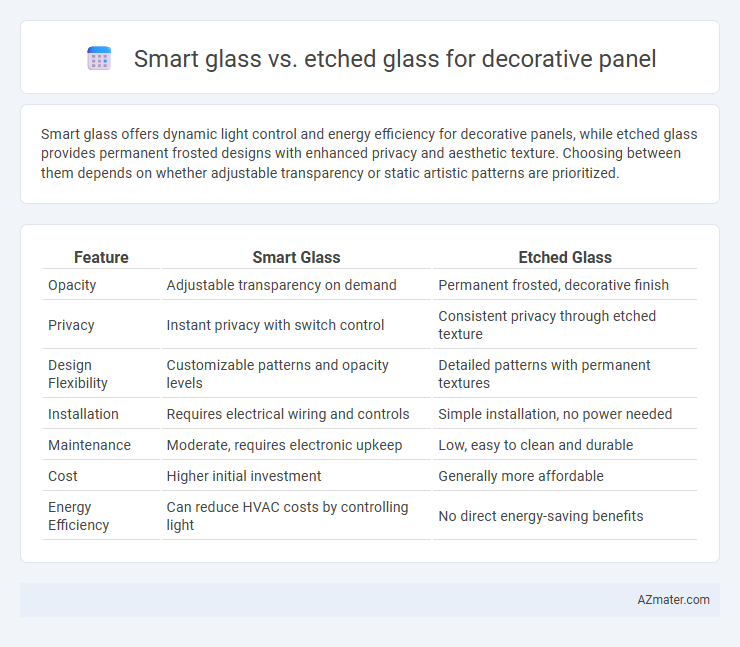Smart glass offers dynamic light control and energy efficiency for decorative panels, while etched glass provides permanent frosted designs with enhanced privacy and aesthetic texture. Choosing between them depends on whether adjustable transparency or static artistic patterns are prioritized.
Table of Comparison
| Feature | Smart Glass | Etched Glass |
|---|---|---|
| Opacity | Adjustable transparency on demand | Permanent frosted, decorative finish |
| Privacy | Instant privacy with switch control | Consistent privacy through etched texture |
| Design Flexibility | Customizable patterns and opacity levels | Detailed patterns with permanent textures |
| Installation | Requires electrical wiring and controls | Simple installation, no power needed |
| Maintenance | Moderate, requires electronic upkeep | Low, easy to clean and durable |
| Cost | Higher initial investment | Generally more affordable |
| Energy Efficiency | Can reduce HVAC costs by controlling light | No direct energy-saving benefits |
Introduction to Decorative Glass Panels
Decorative glass panels enhance interior design by combining functionality with aesthetic appeal, with smart glass and etched glass standing out as popular options. Smart glass offers dynamic light control through electrochromic technology, allowing transparency adjustments for privacy and energy efficiency. Etched glass provides permanent decorative patterns or textures achieved by acid or sandblasting techniques, delivering a classic, frosted appearance ideal for artistic and architectural accents.
What is Smart Glass?
Smart glass, also known as switchable glass, uses electrochromic or liquid crystal technology to change transparency levels on demand, providing privacy and controlling light transmission in decorative panels. Unlike etched glass which has a permanent frosted design created through acid etching or sandblasting, smart glass offers dynamic and customizable opacity, enhancing functionality and aesthetic flexibility. This technology is ideal for modern interiors requiring adaptable privacy and energy efficiency.
What is Etched Glass?
Etched glass is a decorative panel made by using acid or abrasive techniques to create a frosted, translucent surface that adds privacy and artistic detail without blocking light. This glass type provides a tactile texture and elegant, diffused appearance, making it ideal for interior spaces requiring subtle aesthetics. Unlike smart glass, which changes opacity electronically, etched glass offers a permanent design that enhances decor with a timeless, sophisticated finish.
Aesthetic Comparison: Smart Glass vs Etched Glass
Smart glass offers dynamic transparency control, allowing users to switch between opaque and clear states, creating a modern and versatile aesthetic for decorative panels. Etched glass provides a permanent, textured design with elegant frosted patterns that enhance privacy and add a classic, sophisticated look. While smart glass emphasizes innovation and adaptability, etched glass excels in timeless, intricate detailing that complements traditional and contemporary interiors.
Privacy and Light Control Features
Smart glass offers dynamic privacy control by switching from transparent to opaque with an electric signal, enabling instant adjustment of light transmission and visibility. Etched glass provides permanent privacy through frosted patterns that diffuse light, ensuring consistent glare reduction but limited flexibility in light control. Both materials enhance decorative panel aesthetics, with smart glass catering to adaptable environments and etched glass suited for static privacy needs.
Energy Efficiency and Environmental Impact
Smart glass significantly enhances energy efficiency by dynamically controlling solar heat gain and reducing reliance on HVAC systems, making it an environmentally sustainable choice for decorative panels. Etched glass, while aesthetically pleasing, does not offer active thermal regulation and typically results in higher energy consumption due to less effective insulation properties. The lower carbon footprint of smart glass through energy savings and potential integration with green building technologies positions it as a superior option for eco-conscious design.
Installation and Maintenance Differences
Smart glass installation requires specialized wiring and control systems to manage its electrochromic or PDLC technology, demanding professional expertise to ensure proper functionality and safety. Etched glass can be installed using standard glazing techniques without additional electrical components, simplifying the process and reducing initial setup time. Maintenance for smart glass involves periodic checks of electronic elements and cleaning with non-abrasive materials to preserve performance, whereas etched glass primarily requires routine cleaning and occasional surface touch-ups to maintain its decorative appearance.
Cost Analysis: Smart Glass vs Etched Glass
Smart glass typically incurs a higher initial investment compared to etched glass due to its advanced technology and installed control systems, with costs ranging from $100 to $250 per square foot. Etched glass is more cost-effective, averaging $50 to $100 per square foot, as it involves simpler acid or sandblasting techniques without electronic components. Long-term expenses favor smart glass for dynamic privacy and energy savings, whereas etched glass requires minimal maintenance but offers static aesthetics.
Durability and Longevity
Smart glass offers superior durability compared to etched glass due to its advanced polymer layers that resist scratches and impact. Etched glass, while aesthetically appealing with its frosted appearance, tends to be more susceptible to surface wear and discoloration over time. Smart glass panels often provide longer longevity in high-traffic or harsh environments, maintaining clarity and functionality without significant degradation.
Choosing the Right Glass for Your Decorative Panels
Smart glass offers dynamic privacy control and energy efficiency, ideal for spaces requiring adjustable light and visibility. Etched glass provides a permanent decorative solution with intricate patterns and a frosted appearance, enhancing aesthetics without compromising natural light. Selecting the right glass depends on your needs for functionality versus fixed design, budget, and the desired level of light diffusion in your decorative panels.

Infographic: Smart glass vs Etched glass for Decorative panel
 azmater.com
azmater.com